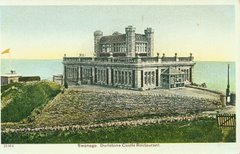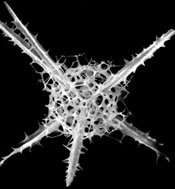 April 20th 2007
April 20th 2007I meet Sam Gibbs at Durlston for a day of thinking about microfossils and also climate change. Sam has recently been looking at a period about 55 million years ago when the climate rapidly heated. She has been studying the effect this had on the plankton in the seas along the current coastline around Swanage.
This of course has relevance for the current moment when we are experiencing rapid climate heating, but now it's very different because:
1 now it's much faster now than it was back then
2 now it's made by humans (Sam calls this 'anthropogenic climate change')
It has come home to me that the project brings me close to the horror of landscape as well as it's beauty. Just to skim too fast over cultural attitudes to the land as represented in visual art for a moment:
For classical artists (17th-century classical landscape painters like Claude Lorraine - nature as harmonious, serene, majestic and, mostly ETERNAL. Often harboring a tiny mythological drama) the landscape was stable signifier of lasting values.
For the Romantics in the nineteenth century landscape was a reflection of the soul. Their sense of the picturesque was a noble expression of suffering nobly endured by unpretending strength of heart.
Land art of the twentieth century (eg Robert Smithson - see 1968 essay "The Sedimentation of the Mind: Earth Projects" working directly with the landscape was a way to engage with social issues and was a metaphor for pure thought.
All these attitudes to nature are strongly anthropocentric, but relations between humanity and nature have changed from nature / the landscape as an untouchable force to a current sense of the terrible fragility of the natural environment faced with the unstoppable force of human impact. Our relationship with landscape is still pretty terrifying, but what we are scared of now is ourselves.
Where am I with all this? In 2000 - 200 2 I worked more directly with the idea of nature than I do now. Mostly the works I made were built on the premise that nature is an artificial cultural construct. I don't feel like this any more. Maybe because since 2002 awareness of climate change has completely altered our concept of 'nature'. In common with the rest of the liberal middle class Sam and I are trapped between horror and helplessness. We are both of the generation that grew up in an atmosphere of fear - the post-cold war fear of nuclear holocaust. I can clearly remember the feeling of horror and helplessness this gave me when I was about fifteen years old. Now I feel the same way about the impact of humans on the environment.
Sam never uses plastic bags ever because of the horrible effect of plastic bags on marine life. She seems always to carry binoculars and a bird-identification guide. The highlights of the day are are for her a peregrine falcon and a spider-orchid. I don't manage to see either of these things and even if I had I don't think they would be meaningful to me in the same way as they are to Sam.
I ask Sam about the effects of Jurassic climate change on the shapes of the plankton - she calls them 'critters' which I now realise is a way to get around the fact that all these microscopic life forms have different names that I as a non-specialist won't know anyway. She tells me that at one point the oceans were dominated by a type of critter that was very calcium-hungry and pretty much sucked all the available calcium from the sea. This meant that other critters which used calcium to build tiny exoskeletons were starved of materials to do this and went from being thick clunky things to far more beautiful and efficient intricate structures. I love this kind of story.
I talk to Sam about my thoughts on starting points for the project, which I have now called 'Shape Shift: landscape in motion'. I've chosen this as a title because it's that sense of constant shifting over time that I think is key, and also the sense that the small shapes of the plankton, themselves shaped by the changes in their environments effect the massive shapes of the cliffs and beaches.
After lunch we walk out along the coast past the lighthouse and see bushes covered in brown caterpillars, we see early purple orchids which Sam photographs. We see apple blossom, which is too early. We pass a patch of burnt ground with blackened tree stumps. Sam points out that ferns are springing up on the scorched earth and describes them as 'opportunistic' species. After the mass extinction (like the one that saw off the dinosaurs) ferns were the first plants to re-colonise the earth.
As I walk along a chalk cliff, I am changed by knowing now that the cliff I stand on is made almost exclusively from fossilised plankton. The gigantic shape and the microscopic shape. The vast time beneath my feet and my momentary lifetime.
I leave with three of Sam's books, which are (in case you want to read them):
A Guide to extant coccolithophore taxonomy, Journal of Nannoplankton Research special issue 1 - 2003 Young, Geissen
Quartenary Environmental Micropaleontology ed Haslett 2002
and
Principals of Paleontology 3rd ed Foote and Miller 2007
the last being my favourite....


No comments:
Post a Comment